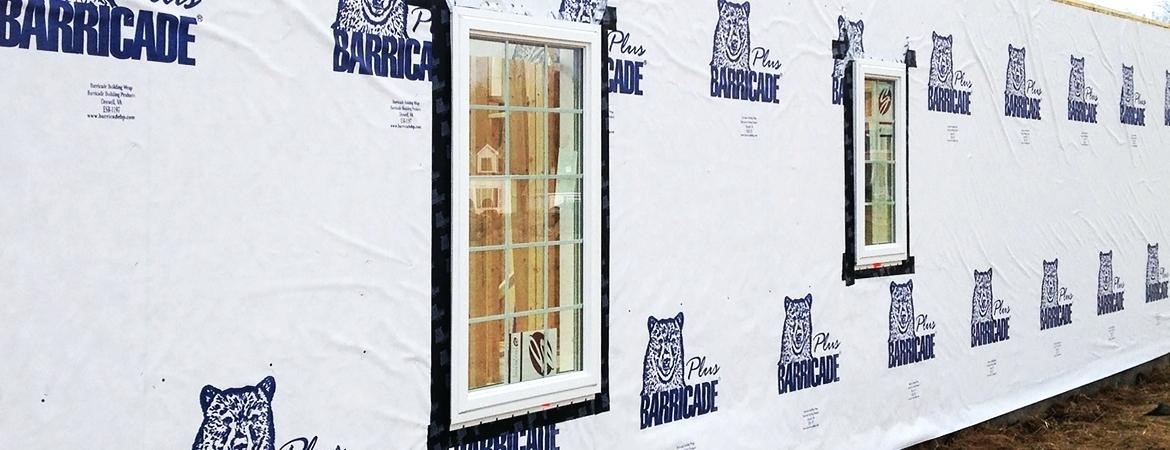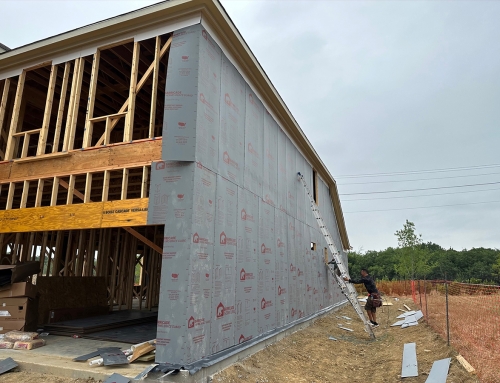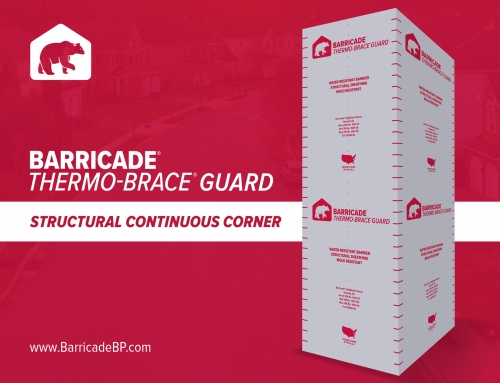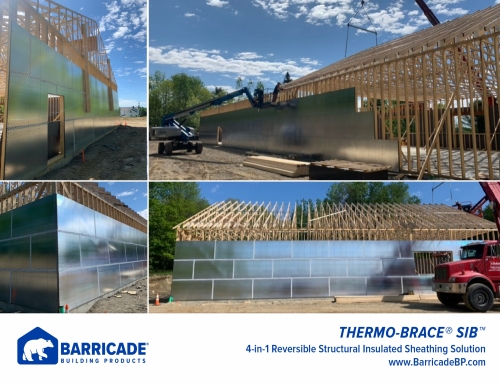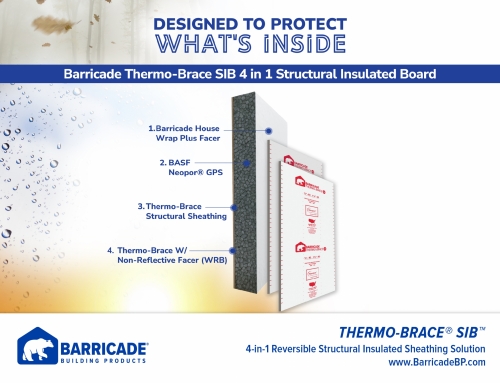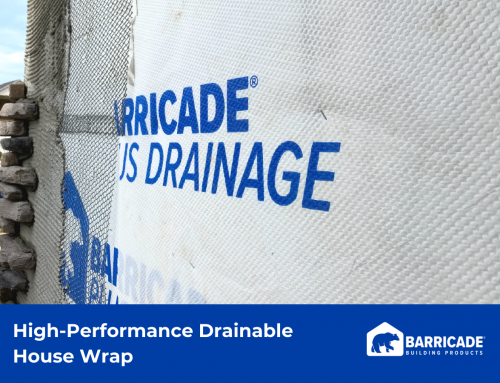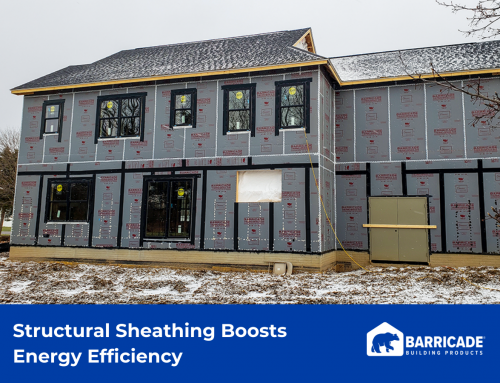The right air barrier system, like Barricade® Building Wrap, is a vital element of a building enclosure. The right air barrier system is needed to ensure energy efficiency, the building’s integrity, and the indoor air quality of the structure. The right air barrier is also crucial to optimizing the performance of the HVAC and the overall comfort of the occupants.
A high-quality air barrier controls airflow, is continuous over the entire building enclosure, can resist damage during and after construction, is durable over the lifetime of the structure, and is compliant with the most recent codes and standards.
Barricade® Building Wrap contains all the needed elements of the right air barrier. Four reasons that Barricade® Building Wrap is the right air barrier is because it is resistant to air infiltration, controls heat loss and gains, and creates a healthy and durable building or home. Notably, Barricade® Building Wrap meets and surpasses the demands of the 2018 IECC R402.4.1 and C402.5.
Four Reasons to Have the Right Air Barrier:
-
The Right Air Barrier will Minimize Moisture Intrusion Due to Air Infiltration
An effective air barrier resists air infiltration, and the moisture associated with it, through the wall system. Moisture may enter a wall system by air flow through the process of thermal convection. Thermal convection happens when warm air (which contains moisture) outside the wall system, is pulled towards the cooler air inside the wall system.
Preventing air transported moisture from getting to the interior of a wall system is vital because when the warm vapor touches the cold interior walls, the vapor turns to liquid by condensation. A strong air barrier resists the flow of air and minimizes moisture intrusion by convection.
Stopping Air Infiltration with a Durable Air Barrier
High durability in an air barrier is also essential to preventing air infiltration. Any defects or damage to the barrier either during or after installation will diminish its performance. The right air barrier has the strength to remain intact during and after construction.
-
The Right Air Barrier will Control Unwanted Heat Loss or Gains
A successful and continuous air barrier controls unwanted heat loss and gains. Controlling heat flow is critical to a building’s energy efficiency and the comfort of the occupants. Importantly, an air barrier must minimize or restrict heat loss and gains through conduction, convection, and radiation.
- Thermal conduction is when warm molecules spontaneously move towards and collide with cooler molecules. The effective R-value of a building’s wall system is its resistance to conduction (the action of hot molecules moving towards cooler molecules).
- Thermal convection is the movement of heat energy from a warmer spot to a cooler spot by the movement of fluids (usually liquids and gases). For example, if it is hotter inside a building than it is outside, the warmer air will move towards the cold air. Minimizing air infiltration (hot air flowing towards cooler air) is critical for stopping the loss of heat energy inside the building.
- Thermal radiation moves heat from warm areas to cold spaces by electromagnetic waves, which is primarily the sun’s rays. Thermal radiation occurs between two surfaces in view of each other; they do not require a substance, like water and air and water, to travel through space. All materials reflect, emit and absorb radiant energy. A product’s ability to radiate absorbed energy, or emit energy as thermal radiation, is called emissivity. A high emissivity product has low reflectivity and will quickly absorb energy that strikes it.
-
The Right Air Barrier, with Proper Permeability, will Control Indoor Air Quality and Preserve the Durability of a Building
An air barrier controls indoor air quality by ensuring evaporation of the moisture within the wall system and preventing infiltration of pollutants; both of which are unhealthy to the occupants of the building. A buildup of moisture within a wall system can lead to mold and rot. Mold is a problem because it diminishes the indoor air quality of a building by producing irritants and allergens. Furthermore, rot can destroy the integrity of a building. The permeability of an air barrier allows moisture to evaporate and is vital to ensure the indoor air quality and integrity of a building.
Permeability is a crucial element of an air barrier because water can invade a wall system to escape. Water can get inside a wall system when rain leaks through the building envelope, through conduction and convection, and from the inside of the building if the HVAC system does not appropriately remove the moisture.
Moisture vapor permeability of an air barrier is critical so the moisture can diffuse and not get trapped in the wall system.
-
The Right Air Barrier Meets Building and Energy Code Requirements
The International Energy Conservation Code® (IECC®) building energy codes and standards set minimum efficiency requirements for new and renovated buildings, which assures reduced energy use and emissions over the structure’s lifetime. The 2018 IECC defines the energy efficiency requirements for both residential and commercial buildings.
Air Barrier Requirements for Residential and Commercial Structures
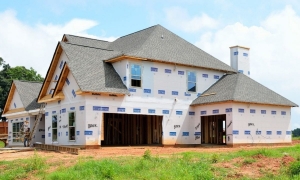
The 2018 IECC® defines an air barrier as one or more materials joined together in a continuous manner to restrict or prevent the passage of air through the building thermal envelope and its assemblies.
Residential Buildings
Location of the air barrier criteria for residential structures is in chapter four of the 2018 IECC (Table R402.4.1.1). The general requirements are a continuous air barrier shall be installed in a building envelope, the exterior thermal envelope contains a continuous barrier, and breaks for joints in the air barrier shall be sealed.
Commercial Buildings
Location of the air barrier criteria for commercial structures is in section C402.5.1 of the 2018 IECC. All climate zones but 2B require air barriers. The 2018 IECC requires for commercial buildings a continuous air barrier throughout the building thermal envelope.
Furthermore, the air barriers shall be permitted to be located on the inside or outside of the building envelope, situated within the assemblies composing the envelope, or any combination thereof. Also, the air barrier shall comply with Sections C402.5.1.1 and C492.5.1.2.
Why Barricade® Building Wrap is the Right Air Barrier for Homes and Buildings
Barricade® Building Wrap is an air- and water-resistant building barrier that stops air infiltration, prevents heat loss and gains, protects air quality and a structure’s durability. It also meets current codes and standards.
- Barricade® Building Wrap is highly air resistance and permeable to vapor, which ensures a comfortable, energy efficient, healthy and durable structure.
- Barricade® Building Wrap maintains it integrity before and after installation which ensures the durability of a building.
- Barricade® Building Wrap withstands 12 months of UV-exposure without damage occurring.
- Barricade® Building Wrap has a tear-stop design with superior strength.
- Importantly, Barricade® Building Wrap meets and surpasses the air barrier requirements of the 2018 IECC R402.4.1 and C402.5.1.
Barricade® building wraps offer the essential elements of the right air barrier: resistance to air infiltration, control over heat loss and gains, and assurance of a healthy and durable structure. Importantly, Barricade® building wraps provide continuous control of airflow over the entire building enclosure and resists damage during and after construction.
Barricade® Building Wrap ensures a building is energy-efficient, durable and has good indoor air quality. For the right air barrier, choose Barricade®.

